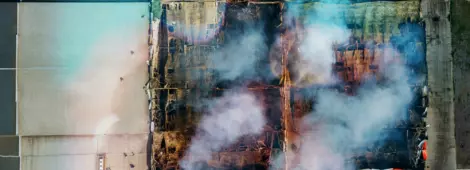
Holistic Structural Fire Engineering
by Mikko Salminen
The Vital Role of Structural Fire Engineering
Structural Fire Engineering (SFE) plays a significant role in improving the safety of buildings and structures by providing an accurate understanding of their behaviors during fires. Standards and building codes are not usually able to prescribe all possible cases and solutions. Therefore, all stakeholders, including manufacturers, architects and designers, must find best practices for new structure types. The holistic approach to structural fire design helps to address the important fire safety challenges related to new building products and designs.
SFE revolves around conducting a comprehensive analysis of the thermal and structural responses of specific structural elements, components or the entire structural framework. This analysis aims to capture the most realistic representation possible, considering all pertinent aspects of the system. Consequently, this approach proves highly valuable when dealing with solutions that lack standardization or involve characteristics that make cost-effective design challenging using more straightforward methods.
Fire Testing of Steel-Timber Hybrid Structures
Fire tests for steel-timber hybrid structures are crucial for ensuring the safety of buildings and structures where these materials are used. By conducting rigorous testing and adhering to established standards, fire performance can be confidently assessed and informed decisions can be made regarding their incorporation into construction projects. Tampere University has studied a lot of timber in fire and conducted fire tests for the steel-timber hybrid section, which is becoming increasingly popular due to its many advantages, including lightweight, sustainable and fast installation.
A recent study published in Fire Technology, “Fire Performance of Steel-Timber Hybrid Beam Section,” investigated the fire resistance of slim-floor steel-timber hybrid systems using cross-laminated timber (CLT). For this study, fire experts from Tampere University, Markku Kauriala Ltd. Fire Engineering and Fire Safety Design Consultants, and Jensen Hughes employed furnace tests and numerical simulations to analyze thermal profiles, temperature development, and charring behavior. A slim-floor steel-timber hybrid beam was examined in testing, featuring a composition comprising a CLT slab and a steel beam constructed with a rectangular hollow section (RHS) and a steel bottom plate (Figure 1).

The primary inquiries addressed in this research included:
- How does the steel profile affect the charring of the timber slab?
- Is it possible to decrease charring, and to what extent, by applying intumescent paint to the steel profile? Intumescent paint consists of a thin layer of paint on the steel surface, which at high temperatures, starts to activate and expand.
- Is it possible to estimate the charring of a timber slab with SFE models?
It was confirmed that if the steel profile is unprotected, the timber slab chars quite similarly behind the steel flange as it would char without it. Intumescent paint in the steel profile reduces the charring in the above slab, as expected. However, it is challenging to avoid charring completely as intumescent paint activates at relatively high temperatures.
The structures were simulated before the fire tests to ensure the simulations were objective. The results of the simulations agreed well with the tested ones. This example shows that SFE can be used to predict the fire performance of innovative or new, non-standard solutions if the model is constructed with care.




To conclude, SFE has a track record of enhancing fire protection strategies for steel, composite and timber structures, and it continues to provide substantial value, when dealing with novel, non-standardized approaches by aiding in the identification of optimal and fire-safe solutions.
Jensen Hughes specializes in providing SFE services that offer a range of valuable benefits. Our expertise in SFE encompasses optimizing fire protection strategies, allowing for exposed structures and innovative solutions, and enhancing the understanding of a structure's behavior in a fire. Jensen Hughes' SFE services are designed to deliver comprehensive analysis and insights that enable safe, innovative, and cost-effective solutions for structural fire safety.
The full paper can be accessed in the August 2023 publication of Fire Technology.
1. Malaska, M., Alanen, M., Salminen, M., Timo, J. & Risto, R. ”Fire Performance of Steel-Timber Hybrid Beam Section.” Fire Technology, 2023. https://doi.org/10.1007/s10694...

Mikko Salminen
Mikko has Ph.D. in Structural Fire Engineering. He has over 15 years of experience in performance-based structural fire safety analysis of steel, timber, and concrete structures to achieve optimal, fire-safe structural solutions ranging…












